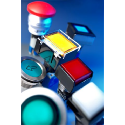Thyristors
Thyristors are a four-layer semiconductor rectifier in which the flow of current between electrodes is triggered by a signal at the third electrode. They act as switches, rectifiers or voltage regulators. As transistors are not good at handling larger currents and turn off the component as soon as the switching current is removed, they are not useful in some devices. Thyristors have the ability to keep the larger current flowing even if the gate current is turned off and will remain in that state until reset. There are various types of thyristor. Some can operate with two or four leads and can have different configurations of the way the anode and cathode are connected to the four layers. The GTO (gate-turn off) is turned on and off by the action of the gate whilst the AGT (anode gate thyristor) connects to the gate near the anode. The base of the photo thyristor is activated by light while diacs work with AC current. As the switching time of thyristors is almost instantaneous, they are widely used as electronic (solid-state) versions of relays. As they can handle a 'real' current, they are also found in speed controls for motors, dimmer switches, surge protectors and alarms.
-
Tennco Distribution Ltd
View company profileAt Tennco Distribution Limited, we are a progressive electromechanical component distributor. We are family owned and operate in niche markets concentrating on electronic and electrical components for the computing, networking, instrumentation, panel building, audio and circuit board assembly industries.
Backed by 30 years experience, at Tennco, we are committed to service and efficient components distribution coupled with ISO 9002 approval. We offer products at competitive prices with a fast friendly and efficient service.
-
Paramount Electronics Ltd
View company profileAt Paramount Electronics we specialise in industrial electronic repairs, exchange circuit boards and the design and manufacture of industrial electronics. Our highly skilled engineers have the knowledge and experience to undertake almost any form of industrial electronic repair, and all repairs are completed at a fixed price with a 2 year guarantee.


